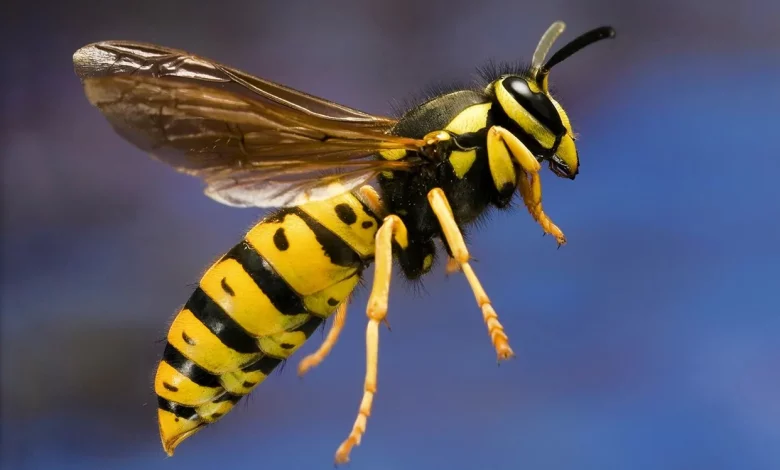The Fascinating World of Wasps: Nature’s Versatile Insect Engineers

Wasps are flying insects belonging to the order Hymenoptera and are closely related to bees and ants. They are known for their distinct slender bodies, narrow waists, and wings. There are thousands of wasp species found worldwide, but the most common types encountered by humans are social wasps, such as yellowjackets and paper wasps.
Social wasps live in colonies with a hierarchical structure consisting of a queen, workers, and males. They construct nests made of paper-like material, which they create by chewing and mixing wood fibers with their saliva. These nests are often found in protected areas such as trees, eaves of buildings, or underground.
While wasps are beneficial to the environment as pollinators and predators of other insects, they can become a nuisance and potential danger to humans. Wasps are known for their defensive behavior and can sting repeatedly if they feel threatened. Wasp stings can be painful and, in some cases, may cause severe allergic reactions or anaphylaxis, which requires immediate medical attention and visit.
Pest control for involves managing or eliminating their nests to reduce the risk of stings and potential damage to property. It is important to note that should only be controlled if they pose a direct threat or are causing significant problems. If the wasps are not causing harm or their nests are located in remote areas away from human activity, it is often best to leave them undisturbed.
Types of Wasps
Here are some common signs that indicate a wasp infestation:
- Sightings
- Nests
- Increased Wasp Activity
- Wasp Nest Material
- Damage to Structures
- Unusual Insect Activity
- Aggressive Behavior
DIY Tips for Wasps
what do wasps eat
Here are some DIY tips to help you manage:
Identify the Nest: Locate the wasp nest, if possible. Exercise caution and keep a safe distance while identifying the nest’s location and access points.
Protective Clothing: Wear protective clothing to minimize the risk of getting stung. Cover yourself with long sleeves, long pants, gloves, and a hat or hood.
Nighttime Approach: Wasps are generally less active during the night. Consider treating the nest when it’s dark, as most of the wasps will be inside the nest.
Use a Wasp Spray: Purchase a wasp spray or insecticide labeled for wasp control. Follow the instructions carefully and use the spray from a safe distance, aiming directly at the nest entrance or the wasps themselves.
Keep Escape Routes Closed: Before spraying, ensure that all windows, doors, and other escape routes near the nest are closed to prevent wasps from entering your living space.
Be Thorough: Apply the spray generously to saturate the nest and ensure that the entire colony is affected.
Wait and Monitor: After treating the nest, keep a close eye on it to check if wasp activity decreases over time. Monitor the area for a few days to ensure that the infestation has been successfully resolved.
Seal Entry Points: Once the nest is inactive, inspect your property for any openings or cracks that could serve as potential nesting sites. Seal these entry points to prevent future infestations.
Prevention Tips for Avoiding Future Wasp Infestations
To help prevent future wasp infestations, consider implementing the following prevention tips:
Seal Entry Points: Inspect your property for any openings, cracks, or gaps in walls, windows, doors, and utility lines. Seal these entry points to prevent gall wasps from entering and building nests.
Secure Garbage and Food: Clean up food spills promptly, and consider using tightly sealed containers for storing food and sweet beverages outdoors.
Trim Vegetation and Trees: Regularly trim trees, bushes, and shrubs near your home.
Remove Attractive Nesting Sites: Remove or modify objects that could serve as attractive nesting sites for wasps.
Cover Openings and Vents: Use fine mesh screens or covers to seal openings in vents, chimneys, and attic openings
Avoid Sweet Fragrances: Wasps are attracted to sweet scents, so avoid using strong perfumes, floral fragrances, or scented cosmetics when spending time outdoors.
Is Safe Wasps Infestation?
Do wasps pollinate?
Having a wasp infestation can present certain risks and safety concerns, especially if the wasps feel threatened or their nests are located in close proximity to human activity. Here are some potential safety considerations regarding a wasp infestation:
- Wasps are capable of stinging multiple times, and their stings can be painful.
- When wasps feel their nest or colony is under threat, they can become aggressive and may exhibit defensive behavior.
- This can include dive-bombing, chasing, and stinging in response to perceived danger.
- The location of a wasp nest can impact safety concerns.
- Attempting to remove or control a wasp infestation on your own without proper knowledge, equipment, or protective gear can increase the risk of stings and potential harm.
- If you or someone in your household is known to have allergies to wasp stings, it is crucial to take extra precautions and consider professional intervention.
Conclusion
This article has provided information on wasps and pest control, including DIY tips and professional options for dealing with a wasp infestation. It emphasized the importance of identifying signs of an infestation, the potential risks associated with wasp stings, and the need for caution when handling nests.
The DIY tips outlined in the article can be helpful for small infestations and minor nest removals.
Overall, addressing a wasp infestation is important for safety and comfort, especially for individuals who are allergic to wasp stings. Seeking professional assistance ensures the proper handling and removal of nests while minimizing risks to both humans and the environment. Taking the necessary steps to prevent and manage wasp infestations can help create a safer and more enjoyable living environment.
More Interesting Contents
OMG Nails
Nikki Taylor
Zendaya
Tom Cruise
Marcheline Bertran
Zillion Heir Cannon





